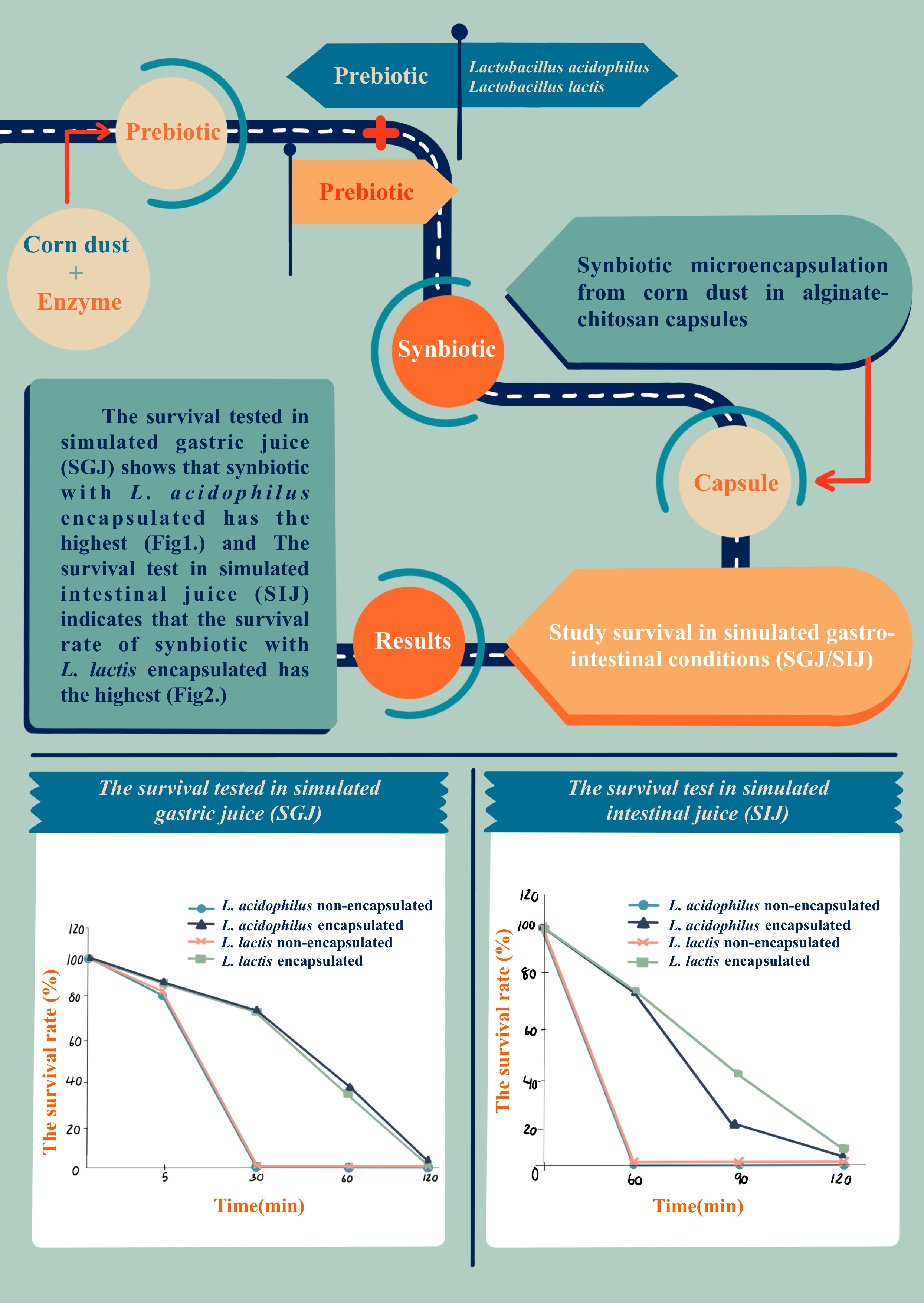Synbiotic Microencapsulation From Corn Dust in Alginate-Chitosan Capsules Improves Survival in Simulated Gastro-Intestinal Conditions
Keywords:
simulated gastro-intestinal conditions, encapsulation, Lactobacillus acidophilus, Lactobacillus lactisAbstract
The research aims to study synbiotic microencapsulation from corn dust in alginate-chitosan capsules whether it improves survival in simulated gastro-intestinal conditions, by studying the survival of synbiotic made from a mixture of corn dust and two of strains probiotic microorganisms such as Lactobacillus acidophilus and Lactobacillus lactis which are not encapsulated and encapsulated in 2% of sodium alginate and coated with chitosan. The survival tested in simulated gastric juice (SGJ) shows that synbiotic with L. acidophilus encapsulated has the highest survival rate of 8.68%; moreover the synbiotic with L. lactis encapsulated has the highest survival rate of 5.43% resulting to L. acidophilus is more resistant to acidity than L. lactis. The survival test in simulated intestinal juice (SIJ) indicates that the survival rate of synbiotic with L. lactis encapsulated has the highest survival rate of 10.29%; in addition, synbiotic with L. acidophilus encapsulated has a survival rate of 5.86%. The difference of the synbiotic that are not encapsulated (p ≤ 0.05) when L. lactis will be resistant as well in bile salt. As a result, the survival rate is higher than the L. acidophilus when replication is in simulated intestinal juice allowing synbiotics can be used as animal feed.
References
[2] A. V. Rao, N. Shiwnavain, I. Maharaj, Survival of microencapsulated Bifidobacterium pseudolongum in simulated gastric and intestinal juiced, Can. Inst. Food Sci. Technol. J. 22(1989) 45-346.
[3] C. Chooprom, Cells encapsulated probiotics with prebiotic and studied survival in acidic conditions and bile salts in vitro, Master of Science thesis biotechnology Songklanakarintara University, Songkla, Thailand, 2016.
[4] C. Maria, M. Izaskun, A. Raquel, C. I. Francisco, M. Florencio, C. V. Maria del, Microencapsulation of a probitic and prebiotic in alginate-chitosan capsules improves survival in simulated gastro-intestinal conditions, Int. J. Food Microbiol. 142(2010) 185-189.
[5] H. Pourjafar, N. Noori, H. Gandomi, A. A. Basti, F. Ansari, Viability of microencapsulated and non-microencapsulated Lactobacilli in a commercial beverage, Biotechnology reports, 2020.
[6] H. Yirga, The use of probiotics in animal nutrition. JPH. 3(2015) 557-569.
[7] I. B. Okey, U. U. Gabriel, S. N. Deekae, The use of synbiotics (prebiotic and probiotic) in aquaculture development, J Biotechnol. 1(2018) 51-60.
[8] N. Chanchay. Synbiotic production from soybean residue for aquaculture practices, J Fish tech, 5(2011) 47-55.
[9] N. Chanchay, K. Dittasuwannakul. Improvement of pre-treating corn dust with enzyme as prebiotics in animal feed, RMUTI J. Sci&Tech. 9(2016) 214-223.
[10] R. Sobel, R. Versic, A. G. Gaonkar. Introduction to microencapsulation and controlled delivery in foods, A practical implementation guide, 2014.
[11] S. C. Siang, L. K. Wai, N. K. Lin, P. L. Phing. Effect of added prebiotic (Isomalto-oligosaccharide) and coating of beads on the survival of microencapsulated Lactobacillus rhamnosus GG, Food. Sci. Tech-brazil, 2019.
[12] S. Kolica, G. R. Gibson. Synbiotics in health and disease. Annual review of food science and technology, 2011, pp. 373-393.
[13] S. Mandal, K Singh. Effect of alginate concentrations on survival of microencapsulated Lactobacillus casei NCDC-298, Int. Dairy J, 16(2006) 1190-1195.
[14] V. Chandramoulia, K. Kailasapathya, P. Peirisb, M. Jones. An improved method of microencapsulation and its evaluation to protect Lactobacillus spp. in simulated gastric conditions, J. Microbiol. Met, 56(2004) 27-35.
[15] Y. Lee, Y. R. Ji, S. Lee, M. J. Choi, Y. Cho. Microencapsulation of probiotic Lactobacillus acidophilus KBL409 by extrusion technology to enhance survival under simulated intestinal and freeze-drying conditions, J. Microbiol. Biotechnol, 29(2019) 721-730.
[16] Y. Zhou, E. Martins, A. Groboillot, C. P. Champagne, R. J. Neufeld. Spectrophotometric quantification of lactic bacteria in alginate and control of cell releasse with chitosan coating, J. Appl. Microbiol, 84(1998) 342–348.









